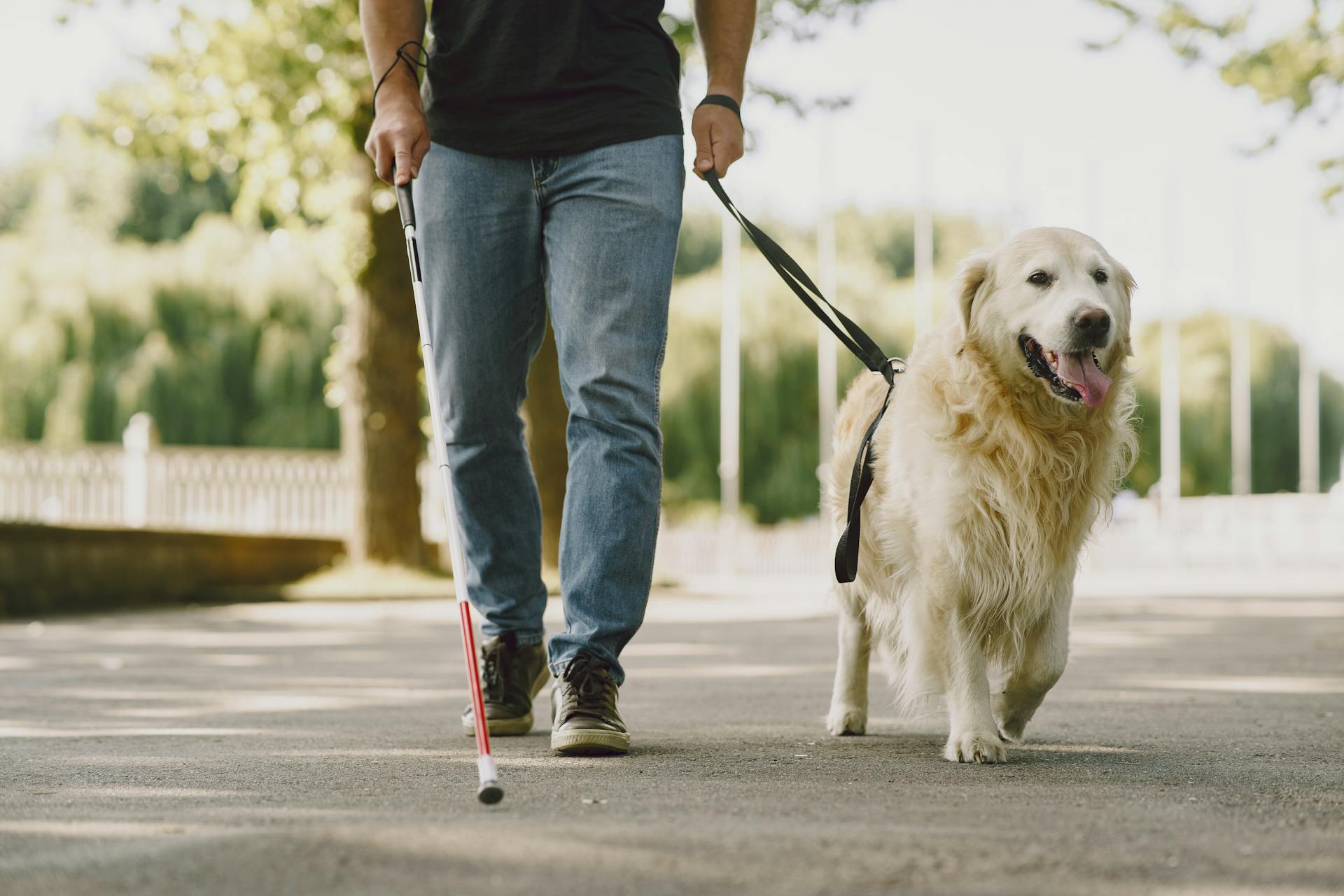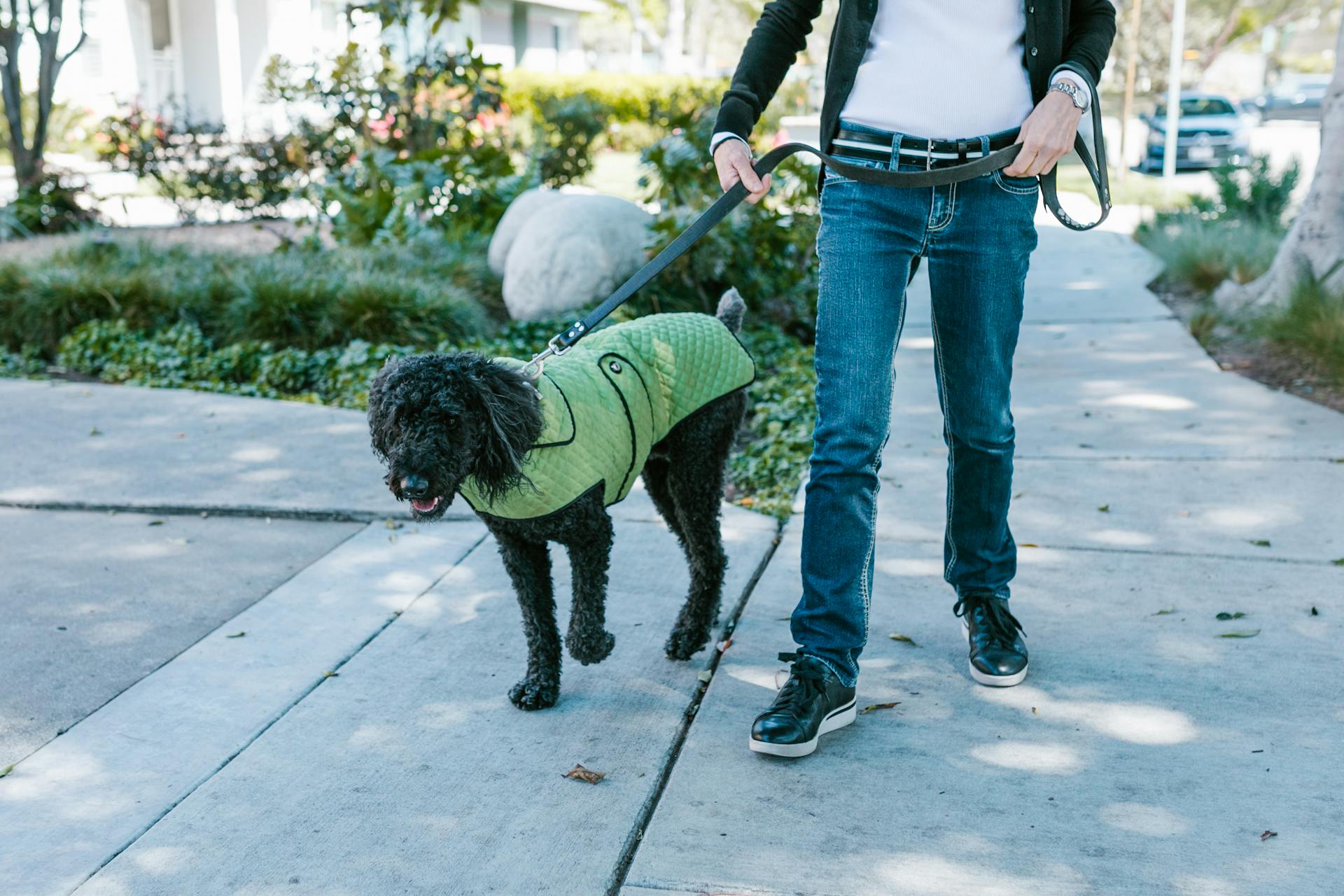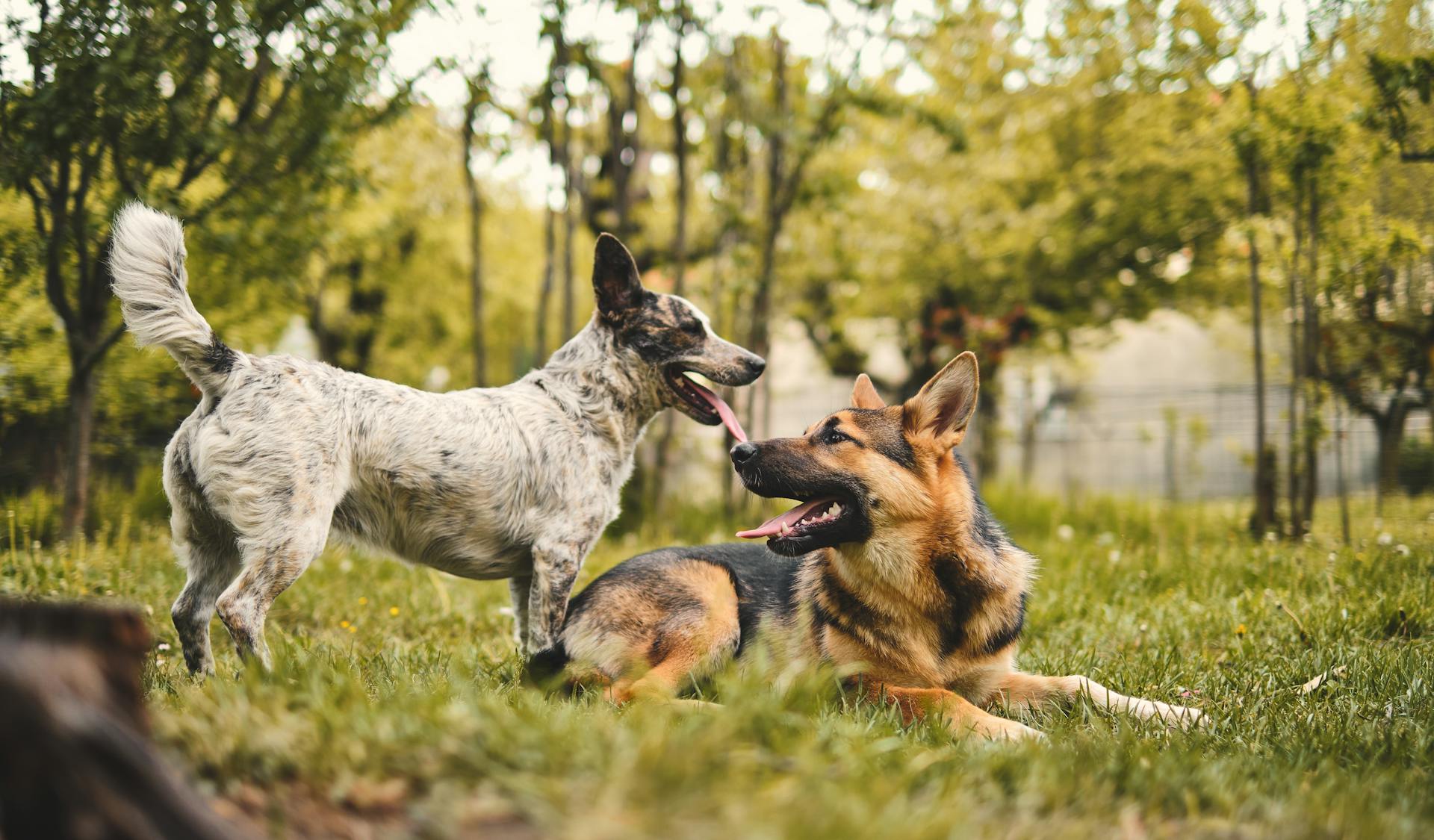
Training your dog to walk beside you is a crucial skill that requires patience, consistency, and positive reinforcement.
Start by choosing a quiet area with minimal distractions where your dog can focus on you.
To begin, attach a leash to your dog's harness, not their collar, to prevent choking.
Next, hold treats close to your left side, the side your dog will eventually walk on, to entice them to follow you.
Curious to learn more? Check out: The Perfect Walk Dog Training
What Is the Heel Command?
The heel command is a precise walking position where your dog walks right beside you, with their neck or shoulder even with your leg. This is different from loose leash walking, which is more about avoiding pulling on the leash.
In traditional obedience competitions, dogs are required to heel on the left side, but you can choose to train both sides or the right side instead. The exact heel position can vary depending on your dog's size, with small dogs' heads and shoulders even with your ankles, and large dogs' necks by your chest.
Here's an interesting read: What Does Heel Mean in Dog Training
Heel training is useful in situations where you need to keep distance between your dog and something dangerous, such as an unfriendly dog or broken glass on the street. It's also helpful for speeding up or slowing down as you walk, and for keeping your dog close to you when exiting the house or car.
To get into heel position with your dog, start by standing in a quiet room with your dog on leash and adjust your position so that they're in the correct heel position. If your dog knows the "stay" command, use it to keep them in one spot while you get into position.
Here are some key differences between heel training and regular leash training:
- Heel training requires a more precise walking position, with your dog's neck or shoulder even with your leg.
- Heel training is useful in situations where you need to keep distance between your dog and something dangerous.
- Heel training helps your dog pay attention to your body and move accordingly, making it easier to keep pace with you.
The Benefits of
Training your dog to walk beside you can have a significant impact on your daily life. Being able to take a walk without your dog pulling is a great relief for your muscles and joints.
Regular outings to new places can help keep your dog's mind happily occupied, breaking up the monotony of daily walks for you too. Dogs can suffer from boredom just like people, and walking them to new places can be a great way to prevent this.
Exercise is a key benefit of walking your dog, with movement being good for their body just like it is for yours. You'll probably get more walking in yourself, making it a win-win for both you and your dog.
Outdoor time is also a huge benefit, with fresh air and a change of pace doing wonders for both you and your dog. You'll likely feel refreshed and happy after walking outside, and so will your dog.
Here are some specific benefits of leash training:
- Being able to take a walk without your dog pulling
- Opportunities to go to new places
- Exercise for you and your dog
- Outdoor time for you and your dog
Training Your Dog
To start training your dog to walk beside you, choose a quiet area with few distractions. Use a flat collar and a 4- or 6-foot leash, not a retractable leash. Fill your pocket or treat pouch with treats and hold them in the hand opposite your dog.
You'll also need to decide which side you want your dog to walk on and hold a few treats on that side of your body. For example, if you want your dog to walk on the left side, hold treats in your left hand. Hold the leash in the hand opposite your dog.
Take a step, then stop, and feed your dog some treats from your hand, in line with the seam of your pants. This will help you position your dog. Repeat this process, taking two steps instead of one before stopping and feeding your dog.
If your dog pulls ahead, stop walking immediately and call your dog back to you. Use the treats in your hand to lure your dog back to your side, but don't treat them yet. Take two to three steps forward before feeding your dog.
As you train, talk to your dog to help keep their attention on you. Gradually take more steps between each treat. When your dog walks well on a loose leash, give this kind of walk a name, such as "heel" or "with me."
Here are some key tips to keep in mind:
- Use a collar or harness, such as a buckle collar, Martingale, head halter, or front-clip harness.
- Hold a few treats on the side you want your dog to walk on.
- Hold the leash in the hand opposite your dog.
- Take a step, then stop, and feed your dog some treats.
- If your dog pulls ahead, stop walking and call them back to you.
- Use verbal cues, such as "heel" or "with me", to signal the start of a walk.
- Gradually increase the number of steps between each treat.
- Release your dog when they no longer need to walk in "heel" position.
Practicing the Heel Command
Practice makes perfect, and practicing the heel command is no exception. Start in a quiet, small room like a bathroom or small bedroom, and put your dog on leash. Stand so that they're in the correct position for the heel command, and adjust where you're standing to make this happen.
To get into heel position with your dog, use masking tape to mark the spot on your leg where you want your dog to be. This spot should be at the height where your dog's nose would be if they were standing next to you and looking forward, so they don't have to reach or jump for the treat.
Once you're comfortable with the leash and dog treats, it's time to practice the heel command. Start by saying the word "heel" right before you take your first step, and then feed a treat at heel position when your dog steps forward with you. As you practice, gradually reduce the frequency of treats to help your dog learn to heel on their own.
Here's an interesting read: Heel Dog Training
Here's a step-by-step guide to practicing the heel command:
Remember to be patient and consistent in your practice, and to reward your dog with treats and praise when they get it right. With time and practice, your dog will learn to heel by your side, even in busy streets and crowded areas.
Practice Handling Treats
Before you start working with your dog, it's a good idea to practice handling the leash and treats without your dog. This might sound silly, but it's essential to get comfortable with the equipment and the sequence of actions.
Use masking tape to mark the spot on your leg where you want your dog to be. This is typically at the height where your dog's nose would be if they were standing next to you and looking forward.
Hold the leash in the hand opposite from where your dog will be, and wear a treat pouch with lots of treats inside. If you're using a clicker, hold it in the same hand as the leash.
Here's an interesting read: Hand Signs for Dog Training
Say a word of praise or click your clicker, then take a treat from your treat pouch and pretend to feed it to your dog at the marked level. Return your hand to the spot near your belly button and repeat the sequence smoothly.
Here's a checklist to help you practice handling treats:
- Mark the spot on your leg with masking tape
- Wear a treat pouch with lots of treats inside
- Hold the leash in the opposite hand from where your dog will be
- Practice the sequence of actions smoothly
Take a Step Forward
To teach your dog to heel, you'll need to take a step forward and encourage them to follow. This is a crucial part of the heel training process, and it's essential to do it correctly to avoid confusing your dog.
Take a tiny step forward, keeping the leash loose. Don't pull your dog; let them decide what to do. Wait for them to lean or step forward so they're back in heel position. As soon as they are, praise or click, and feed a treat at the marked space by your leg.
If your dog does not step forward or seems stuck, walk around them in a circle, keeping your "heel" leg next to them until they stand up at roughly the right position. As soon as they do, praise/click and feed them a treat at the spot beside your leg.
Repeat this step until your dog moves forward with you every time you take a small step. Then gradually increase the size of your steps until you work your way up to your normal stride length.
A different take: Position Box Dog Training
Tips and Tricks
Training a dog to walk beside you can be a fun and rewarding experience for both you and your furry friend. The key is to make it a positive and enjoyable experience for your dog.
Practice in short training sessions, lasting no more than five minutes, to keep your dog engaged and focused. This will help prevent boredom and frustration.
You may need to use extra-tasty treats to keep your dog's attention outdoors at first, especially if they're easily distracted by sights and smells.
Release your dog to sniff and explore as often as possible when you're using the heel command on walks. This will help them feel more comfortable and in control.
Let your dog set the pace on walks, rather than trying to keep them in heel position all the time. This will make the experience more enjoyable and useful for your dog.
Having trouble with heel training? Consult a certified professional dog trainer for personalized guidance and support.
Advanced Training Techniques
To train your dog to walk beside you, you'll want to start by using a harness instead of a collar, as it's more comfortable for them and helps prevent pulling.
Using positive reinforcement is key, so be sure to reward your dog with treats and praise when they walk beside you without pulling on the leash.
A consistent walking schedule is essential, aiming for at least 30 minutes a day to help your dog get used to the rhythm of walking beside you.
By incorporating turns and changes in direction, you can help your dog learn to stay by your side and not get distracted by their surroundings.
It's also helpful to practice walking in different environments, such as on sidewalks, trails, and in crowded areas, to help your dog become confident and calm in various situations.
By being patient and consistent, you can help your dog learn to walk beside you without pulling on the leash, making walks a more enjoyable experience for both of you.
Consider reading: Dog Aggression after Neutering
Walking and Safety
Walking and Safety is a top priority when training your dog to walk beside you. Place a treat or toy on the floor and stand 15-20 feet away with your dog on leash to begin teaching loose-leash walking.
It's essential to start with a safe distance to avoid any potential pulling or lunging. Begin walking towards the treat or toy, and if the leash remains loose, continue walking. If your dog lunges, stop immediately.
If your dog is very treat-motivated and continues to lunge, try a lower-value treat, such as a dog biscuit, and use it when they're not hungry. This can help them focus on the reward rather than the temptation.
Worth a look: Loose Leash Dog Training
Troubleshooting Common Issues
If you're experiencing common behaviors while on leash, try leash training tips to curb them. Leash pulling is a common issue that can be addressed by starting with short training sessions and gradually increasing the duration.
Leash pulling can be caused by excitement or lack of training, so it's essential to focus on basic obedience commands before heading out on walks.
To address this issue, try using positive reinforcement techniques, such as rewarding your dog with treats for walking beside you.
Troubleshooting

Troubleshooting common issues with your dog can be frustrating, but don't worry, I've got some tips to help you get back on track.
If your dog is pulling on the leash, try feeding more treats or using super-delicious ones to keep them engaged. This can make a big difference in their behavior.
Leash training can be challenging, but with the right approach, you can overcome common obstacles. One common issue is pulling, which can be caused by too few treats, not tasty enough treats, or a situation that's beyond your dog's level of training.
Feeding your dog too few treats can lead to pulling on the leash, so it's essential to keep them satisfied with a steady stream of rewards. You can also try using treats that are high-value, like cheese or liver, to keep them engaged.
If your dog is having trouble with leash training, try taking them to an easier location, like a quiet park or a flat area without distractions. This can help them focus and learn more effectively.
For your interest: Dog Diaper Training
Aggressive Behavior

Aggressive Behavior can be a real challenge to deal with, especially when your dog starts lunging or chasing something. Stop walking and hold steady, rather than yanking on the leash.
Calling your dog's name in a cheerful tone, making kissy noises, or stamping your feet can help get their attention. This can be a great way to refocus your dog and calm them down.
If your dog is too distracted to respond, you may need to gently pull them away. To do this, anchor your leash hand against your belly button and calmly walk away with the leash held firmly at your abdomen.
Directing your gaze, shoulders, and hips in the direction you're walking can help your dog follow you, as it implies you're walking toward something interesting. This can be a great way to spark their curiosity and encourage them to join you.
On a similar theme: Send Away Dog Training
Frequently Asked Questions
Should dogs walk beside you or in front of you?
Dogs should walk beside or behind you, not in front, to establish a clear leader-followers dynamic. Walking your dog, not the other way around, is key to a harmonious and enjoyable walk.
What is the #1 trick to stop your dog from pulling on the leash?
Stop walking when your dog pulls, and reward them with treats for walking by your side. This simple trick trains your dog to walk politely without pulling on the leash
Featured Images: pexels.com


